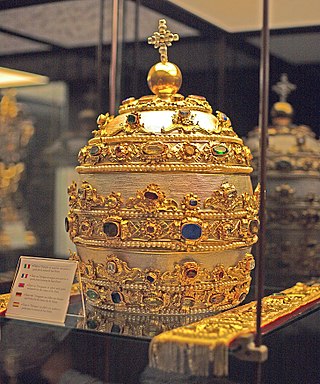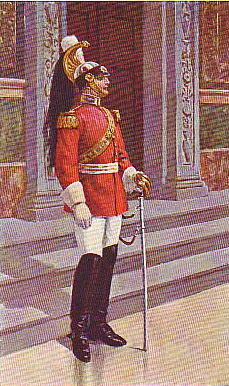
The papal tiara is a crown that was worn by popes of the Catholic Church from as early as the 8th century to the mid–20th century. It was last used by Pope Paul VI in 1963, and only at the beginning of his reign.

Monsignor is an honorific form of address or title for certain members of the clergy, usually of the Roman Catholic Church. Monsignor is the apocopic form of the Italian monsignore, meaning "my lord". "Monsignor" can be abbreviated as Mons. or Msgr. In some countries, the title "monsignor" is used as a form of address for bishops. However, in English-speaking countries, the title is dropped when a priest is appointed as bishop.
Master of the Horse is an official position in several European nations. It was more common when most countries in Europe were monarchies, and is of varying prominence today.

A Papal Mass is the Solemn Pontifical High Mass celebrated by the Pope. It is celebrated on such occasions as a papal coronation, an ex cathedra pronouncement, the canonization of a saint, on Easter or Christmas or other major feast days.
A master of ceremonies, abbreviated MC or emcee, is the official host of a ceremony, staged event, conference, convention, or similar performance.

Papal regalia and insignia are the official items of attire and decoration proper to the Pope in his capacity as the visible head of the Catholic Church and sovereign of the Vatican City State.

The Noble Guard was one of the household guard units serving the Pope, and formed part of the military in Vatican City. It was formed by Pope Pius VII in 1801 as a regiment of heavy cavalry. Conceived as the Pope's personal guard, the unit provided a mounted escort for the Pope when he moved about Rome in his carriage and mounted guard outside his apartments in the papal palaces. The guardsmen were also available for special missions within the Papal States at the behest of the pope. One of their first major duties was to escort Pius VII to Paris for the Coronation of Napoleon I in 1804.

Georg Gänswein is a German prelate of the Catholic Church who served as Prefect of the Papal Household from 2012 to 2023 and was the Personal Secretary of Pope Benedict XVI. He was a Professor of Canon Law at the Pontifical University of the Holy Cross for about a decade and has been an Archbishop since 2012.
The papal household or pontifical household, called until 1968 the Papal Court, consists of dignitaries who assist the pope in carrying out particular ceremonies of either a religious or a civil character.
The Prefecture of the Papal Household is the office in charge of the Papal Household, a section of the Roman Curia that comprises the Papal Chapel and the Papal Family.
The Prince Assistant to the Papal Throne was a hereditary title of nobility available in the Papal Court from the early sixteenth century until the reforms of Pontificalis Domus by Pope Paul VI in 1968, when the Papal Court was reformed into the current Papal Household. The title is not currently in use, though it has not been formally suppressed.

The black nobility or black aristocracy are Roman aristocratic families who sided with the Papacy under Pope Pius IX after the Savoy family-led army of the Kingdom of Italy entered Rome on 20 September 1870, overthrew the Pope and the Papal States, and took over the Quirinal Palace, and any nobles subsequently ennobled by the Pope prior to the 1929 Lateran Treaty.
The Roman Court or Papal Curia was reformed by the papal bull Pontificalis Domus issues by Pope Paul VI in 1969. It abolished the role of the old Roman nobility at the papal court with the exception of the position of Prince Assistant to the Papal Throne. The titles abolished, such as the Grand Master of the Sacred Apostolic Hospice and Marshal of the Holy Roman Church and the Sacred Conclave, remain heredity but are now purely honorary.

A chamberlain is a senior royal official in charge of managing a royal household. Historically, the chamberlain superintends the arrangement of domestic affairs and was often also charged with receiving and paying out money kept in the royal chamber. The position was usually awarded as an honour to a high-ranking member of the nobility (nobleman) or the clergy, often a royal favourite. Roman emperors appointed this officer under the title of cubicularius. The Chamberlain of the Holy Roman Church enjoys very extensive powers, having the revenues of the papal household under his charge. As a sign of their dignity, chamberlains bore a key, which in the seventeenth century was often silvered, and actually fitted the door-locks of chamber rooms. Since the eighteenth century, it has turned into a merely symbolic, albeit splendid, rank-insignia of gilded bronze. In many countries there are ceremonial posts associated with the household of the sovereign.

The Pontifical Swiss Guard is an armed force and honour guard unit maintained by the Holy See that protects the Pope and the Apostolic Palace within the territory of the Vatican City. Established in 1506 under Pope Julius II, the Pontifical Swiss Guard is among the oldest military units in continuous operation.

Chaplain of His Holiness is a title of distinction given by the Pope in recognition of a priest’s service to the Church. They are addressed with the honorific of "Monsignor" and have certain privileges with respect to ecclesiastical dress and vestments. In 2013 Pope Francis amended common practice to require that all such priests be at least 65 years of age.

Pontificalis Domus was a motu proprio document issued by Pope Paul VI on 28 March 1968, in the fifth year of his pontificate. It reorganized the Papal Household, which had been known until then as the Papal Court.
The orders, decorations, and medals of the Holy See include titles, chivalric orders, distinctions and medals honoured by the Holy See, with the Pope as the fount of honour, for deeds and merits of their recipients to the benefit of the Holy See, the Catholic Church, or their respective communities, societies, nations and the world at large.

The papal nobility are the aristocracy of the Holy See, composed of persons holding titles bestowed by the Pope. From the Middle Ages into the nineteenth century, the papacy held direct temporal power in the Papal States, and many titles of papal nobility were derived from fiefs with territorial privileges attached. During this time, the Pope also bestowed ancient civic titles such as patrician. Today, the Pope still exercises authority to grant titles with territorial designations, although these are purely nominal and the privileges enjoyed by the holders pertain to styles of address and heraldry. Additionally, the Pope grants personal and familial titles that carry no territorial designation. Their titles being merely honorific, the modern papal nobility includes descendants of ancient Roman families as well as notable Catholics from many countries. All pontifical noble titles are within the personal gift of the pontiff, and are not recorded in the Official Acts of the Holy See.
The Dicastery for the Service of Charity, also known as the Apostolic Alms Office, is an administrative unit of the Roman Curia. It began operations on 5 June 2022 as established by the apostolic constitution Praedicate evangelium promulgated on 19 March 2022. Before the reform of Praedicate evangelium it was named the Office of Papal Charities.














